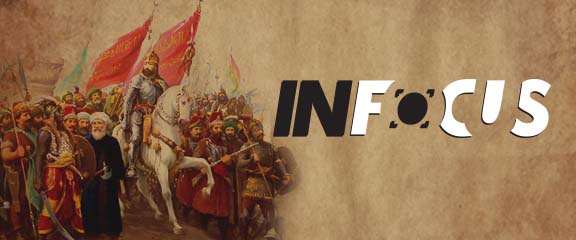Vietnam is a country of 100 million people with a GDP (Gross Domestic Product) worth $262 billion, a per capita GDP of $2700, and exports worth $264 billion. Vietnam is clearly more prosperous than Pakistan with its population of 225 million people, GDP of $278 billion, a per capita income of $1200, and exports worth $23 billion.
Great Britain, India’s colonial master, won the Second World War, but exhausted by five hard years of a war for survival, decided to withdraw from the Empire, with its policy of divide and quit. Vietnam was a colony, ruled by the French, who were determined to hold onto their empire. When Germany conquered France, ending French imperial ambitions, Japan took over Vietnam. In 1945, the US dropped two atomic bombs on Hiroshima and Nagasaki, defeated Japan and ended her empire in the Far East. At the Potsdam Conference of 1945, it was decided that South Vietnam would surrender to Admiral Mountbatten of Great Britain, and North Vietnam would surrender to Chiang Kai-shek of China. Chiang Kai-shek was defeated and driven into exile by Mao and his Communists in 1949. From 1946 till 1954 the communist Viet Minh, led by their great leader Ho Chi Minh and their brilliant general Vo Nguyen Giap, fought the First Indochina War and defeated the French. The US was determined not to allow Communism to sweep over the countries of the Far East and they backed South Vietnam, starting the Second Indochina War. Finally in 1975, after the death of 58,000 American soldiers (and over 2 million Vietnamese), the US withdrew and the communists took Saigon, unifying North and South Vietnam into one nation. Though Ho Chi Minh was dead by that time, the Communists renamed Saigon as Ho Chi Minh City in memory of the man who had led and inspired their nation.
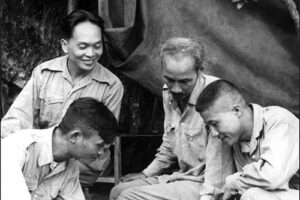
Ho Chi Minh is one of the greatest leaders of the twentieth century. Born in 1890, he was 4 feet 11 inches tall and weighed less than 100 lbs. His father was a Confucian scholar. In 1911, Ho left for France as a dishwasher on a ship. He worked on ships for six years, travelling the world. He lived in exile from his home country for 30 years, working as a kitchen help, pastry cook, journalist and revolutionary. He founded a revolutionary newspaper and was condemned to death in French Indochina. In 1941, after the conquest of France by Germany, he returned to the jungles of Vietnam, without followers, guns, or money, to fight the French and then the Japanese. He lived an underground life with many aliases to hide his real identity. To the peasants of Vietnam, he was Uncle Ho, the kind, gentle, and loving elder; to his powerful enemies around the world, he was the astute, resolute, and tireless fighter for Vietnam’s independence. Ho loved reading, gardening, and feeding his fish. When America escalated their inhumane bombing of Vietnam, Ho simply advised them, “You can kill ten of my men for every one I kill of yours. But even at those odds, you will lose and I will win.” Uncle Ho spoke English, French, Mandarin and Cantonese Chinese, Russian, and could hold a conversation in the universal language, Esperanto. He was a guerrilla fighter, writer, poet, teacher, revolutionary, politician, leader and international statesman. He achieved the impossible by defeating France, Japan, America, and South Vietnam. Ho died in 1969, at the age of 79.
The Viet Minh, North Vietnam’s army, was led by Vo Nguyen Giap, a military genius with no formal military training, who transformed a tiny band of guerrillas comprising 31 men and three women armed with flintlock riffles, into an army that defeated both France and the US. Giap was a student of Law from Hanoi University, who taught himself the art of war. He was fascinated by Napoleon’s tactics and could draw all of Napoleon’s battle plans from memory. He was known as the Red Napoleon. He was also an avid student of Mao’s theories of guerrilla warfare. When Hanoi fell to the Viet Minh in 1945 and Ho proclaimed the Democratic Republic of Vietnam, Giap was appointed Defence Minister. In 1954, Giap defeated the French army in the Battle of Dien Bien Phu, where his guerrillas trapped the French in a valley and massacred them with fire from the surrounding hills. The French were replaced by the US, who waged a fierce and bloody war against North Vietnam till they were finally defeated in 1975, when the Tet Offensive was launched on 40 cities simultaneously and, in Saigon, a suicide squad invaded the US embassy. Defeat in the Tet Offensive led to the withdrawal of US forces. In 1976, five years after Pakistan was split by the secession of Bangladesh, North and South Vietnam were united and the Socialist Republic of Vietnam was born.
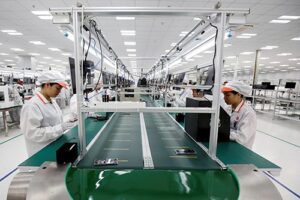
Giap was independent-minded. He was an outstanding military genius who believed ‘People should not be overawed by the power of modern weapons. It is the value of human beings that, in the end, will decide victory.’ Giap was the first general to defeat the forces of the US in a war.
While Ho favoured the simple peasant life, Giap was fond of luxury, wore crisp uniforms, lived in a grand French colonial mansion, and carried on a scandalous affair with a beautiful nightclub dancer. He was sidelined and retired from his post as Minister of Defence in 1981, retired from the politburo in 1982, but remained Deputy PM till 1991, with the charge of Science and Technology along with Population Control. Perhaps it is a coincidence that these portfolios have been important success stories in modern Vietnam, and the Two-Child Policy contributed to Vietnam’s economic growth. Giap died on October 4, 2013, at the age of 102.
The economic recovery of Vietnam was no less remarkable than its military struggle. In 1975, the per capita GDP of Vietnam was $80 (half of Pakistan’s per capita GDP in 1975 of $164). Today, in 2021, Vietnam’s per capita GDP is $2700 — more than double Pakistan’s $1285. This was despite the massive reconstruction required after the US bombing, which in the 10 years (1965-1975) saw 7.5 million tons of bombs dropped on Vietnam, Laos, and Cambodia (double the amount dropped on Europe and Asia in the Second World War), pound for pound, the largest aerial bombardment in history. Around 270 million cluster bombs were dropped on Vietnam, 210 million more than dropped on Iraq in 1991, 1998, and 2006 combined.
Massive bombing not only killed and displaced millions, it resulted in total destruction of infrastructure, roads, bridges, schools, hospitals, and factories. The destruction included 65 percent of all oil storage capacity, 59 percent of all power plants, 55 percent of the bridges, and the ports and water supply. Vietnam had a lot of catching up to do before worrying about growth.
After the war, when a united Vietnam achieved its independence, the economy did not do well. The US embargo (1975 -1994) made recovery difficult, if not impossible. Bureaucratic mismanagement, Communism, extinction of the entrepreneur class, and military adventurism in Cambodia, kept the economy stagnant. But in the mid-1980s, the Doi Moi reforms turned the Soviet model economy into a Socialist Oriented Market Economy and growth started. Between 1985 and 2021, the per capita GDP moved from a low of $230 to a high of $2,700 (10 times), whereas Pakistan’s per capita GDP rose from $337 in 1985 to $1200 in 2021 (4 times).
Vietnam invested heavily in education, raising the skills of its workforce. It also recognised the dangers of excessive population growth, and imposed a two-child policy, which led to greater female participation in the workforce. Investment in infrastructure, which had been destroyed in decades of war, and also in the new technology of internet, helped economic growth. Pro-business policies and reduction of bureaucratic red tape improved global competitiveness and the ease of doing business. Contracts were enforced and electricity and credit were readily available. Manufacturing increased, and incentivisation of agriculture led to a growth in high value crops, and also increased productivity in the major crops of rice and coffee. Tourism boomed as the number of tourists increased from 10 million in 2016 to 18 million in 2019. Privatisation eliminated the bleeding white elephant SOEs (state-owned enterprises), reducing the 12,000 SOEs to 600.
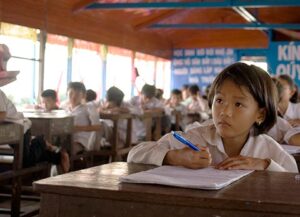
Vietnam’s greatest success was in its exports. By 2020, Vietnam’s exports had reached $264 billion (over 100 percent of her GDP). In comparison, Pakistan’s exports were stagnant at $23 billion (less than 10 percent of her GDP). Vietnam’s population is 100 million — roughly half of Pakistan’s population amounting to 225 million. Vietnam’s high volume export of clothing and shoes have been overtaken by its export of mobile phones, computers, and electronic products as international companies move to a China Plus One policy of diversification to avoid complete dependence on China. Apple, Samsung, and Nike have set up sizeable operations in Vietnam. The greatest export success story is Samsung, which has invested $17 billion, employs over 200,000 workers, has two of its largest factories in Vietnam, and has sales revenues of $58 billion, contributing a quarter of Vietnam’s total exports. Vietnam’s cheap, skilled, and productive labour force attracts multinationals and raises the inflow of FDI (Foreign Direct Investment). After the end of the US embargo, and its gaining membership of the WTO (World Trade Organisation), Vietnam has made best use of Free Trade Agreements to promote its trade and maximise its exports.
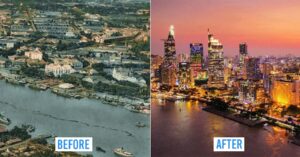
Pakistan, on the other hand, has labour with low education levels, resulting in low-productivity. Corruption, bureaucracy, political instability, law and order, weak property rights, delays in courts, and weak enforcement of contracts, discourage investors from abroad, resulting in dismal levels of FDI. Pakistan enters into Free Trade Agreements, but does not take them as seriously. Its two most important FTAs are with South Asia (meaningless with the hostile Pak-India relationship) and with China, where the first FTA had to be replaced by a second FTA, since the terms were considered too one-sided, favouring China and being unfair to Pakistan. Samsung has, this year, started production of smart phones in Pakistan to initially supply the large domestic market.
Pakistan’s journey has been a joy-ride when compared to Vietnam’s hard history. If Vietnam has succeeded despite all that it has suffered, then surely there is hope for Pakistan, but the first step is recognising what has gone wrong, before we can hope to put it right. Pakistani leaders could learn a lesson from Vietnam’s Communist Party leaders, who apologised to the nation for mismanagement of the economy in 2012, after SOEs went bankrupt and inflation surged. The 200 percent hyperinflation of 1982 and the high inflation of 81 percent in 1991 have been controlled and reduced to three percent.
The formula of success for all developing nations are the same — education and technology, population control, productivity of the workforce, good governance, efficient institutions, law and order, political stability, a trustworthy legal system which respects both human and property rights and speedily gives justice and, most importantly, leaders who are bold, skilled , and dedicated.
Does Pakistanis have the values and attitudes that build successful nations? Are those that govern Pakistan ready to put the welfare of the nation above personal careers and wealth?
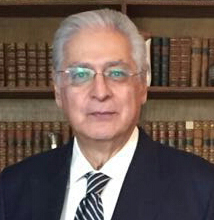
The writer is a businessman and the author of three books including Muslims: The Real History.


